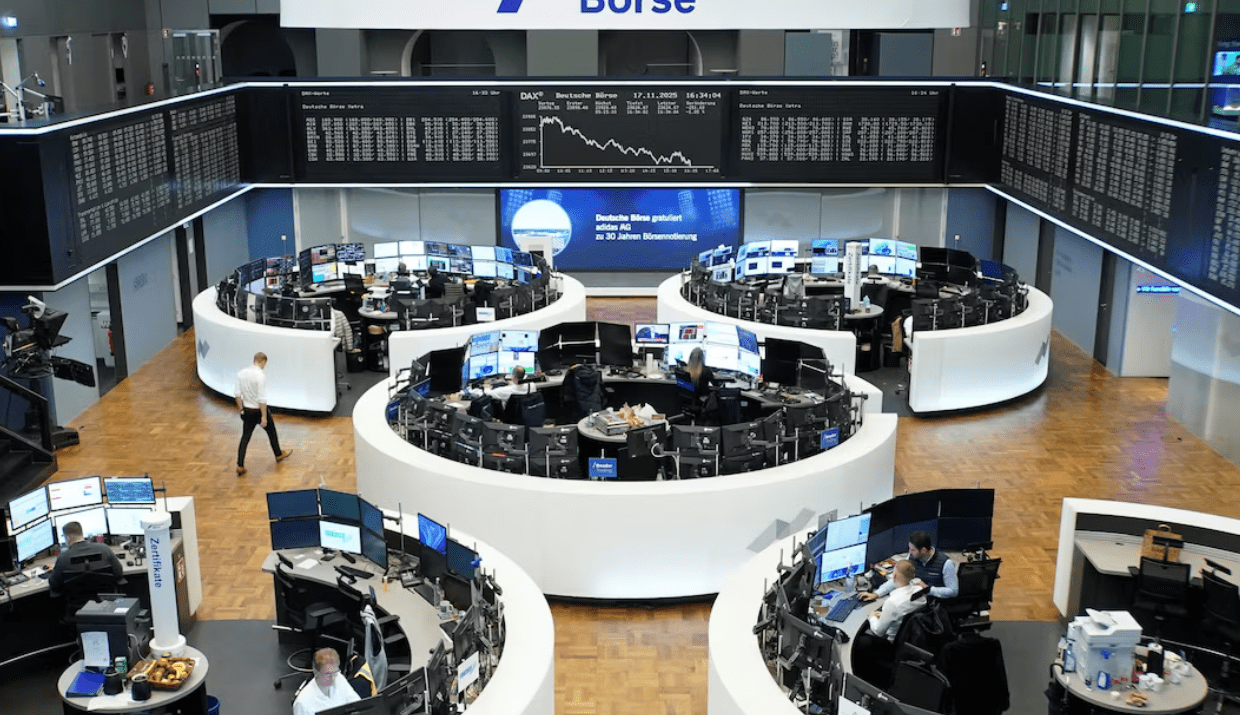European stocks fell sharply on Tuesday, mirroring the global risk-off mood as investors grew increasingly concerned about stretched tech valuations and fading expectations for a near-term Federal Reserve rate cut.
The STOXX 600 dropped 1.1% to a one-week low, with major benchmarks in Germany (DAX) and France (CAC 40) sliding more than 1.2%. Banking stocks led the decline, with the SX7P and SX7E indexes falling over 2%, reflecting broader caution across the region.
Tech-Led Selloff Hits Europe
With Wall Street anxiously awaiting Nvidia’s earnings on Wednesday, fears of an AI bubble continued to ripple across markets.
European industrial and AI-linked names dropped sharply:
- ABB fell 4% after reaffirming guidance — a move that underwhelmed investors.
- Schneider Electric slipped 2%.
- Siemens Energy lost around 3%.
The weakness reflects increasing doubt about whether AI-related capex, valuations, and revenue expectations can continue to support the sector’s rapid growth.
Fed Anxiety Weighs on Sentiment
Global markets have been on edge as hawkish commentary from several Fed policymakers lowered the odds of a December rate cut to roughly 42%, down from almost 100% earlier this year.
The delayed September U.S. jobs report, due Thursday following the end of the government shutdown, is now expected to be a pivotal catalyst. Private surveys show signs of cooling labor demand, but policymakers have signaled they want more evidence before easing again.
A Bright Spot: Roche Surges
Swiss drugmaker Roche jumped nearly 6% after positive late-stage trial results for its breast cancer therapy giredestrant, providing one of the few pockets of strength across the region’s market.
EU Bankers Expect Disappointment From Capital Buffer Reforms
European banking executives are bracing for the upcoming EU capital buffer proposals to fall short of expectations, according to people familiar with the matter, as the bloc prepares a broad review of the banking system ahead of 2026.
A special task force of senior euro-area officials is set to deliver recommendations on liquidity, buffers, and efficiency measures to the European Central Bank by year-end. These findings will shape the European Commission’s 2026 bank-sector report, one of the most anticipated regulatory papers of the cycle.
But industry leaders fear the reforms will lag far behind US deregulation, which has accelerated under the Trump administration — widening the competitiveness gap between American and European lenders.
Banks have spent years arguing that overly rigid capital requirements and cross-border restrictions have limited profitability, scale, and lending capacity. However, early signals suggest only modest adjustments are likely, frustrating executives who hoped for a more ambitious overhaul.
Disclosure: This article does not represent investment advice. The content and materials featured on this page are for educational purposes only.
Related: What to Watch in Markets This Week: Nvidia, Big Retail, a Delayed Jobs Report










